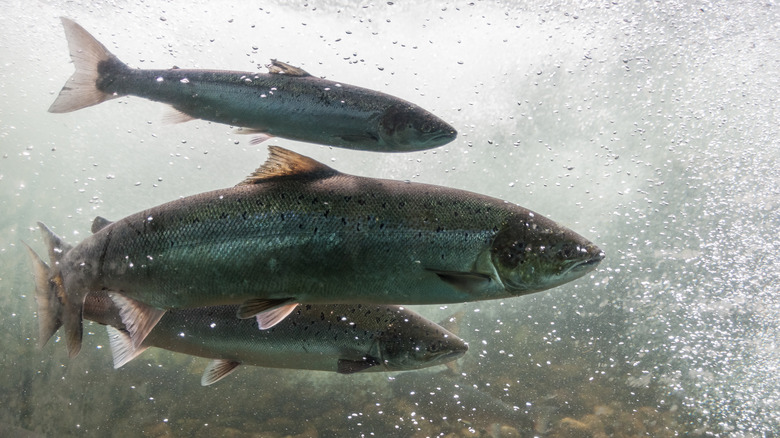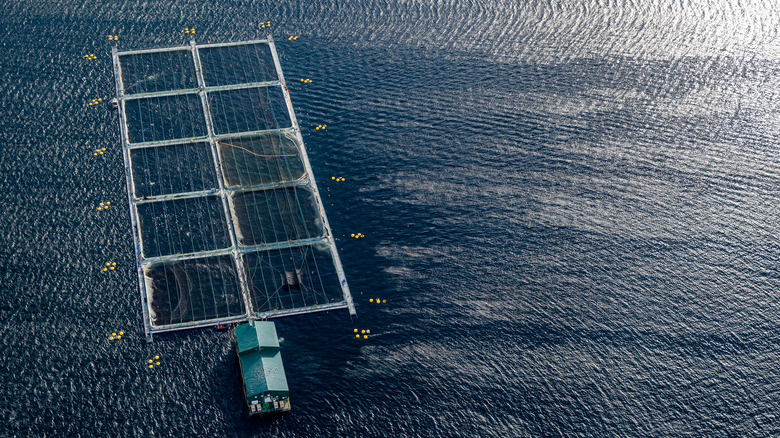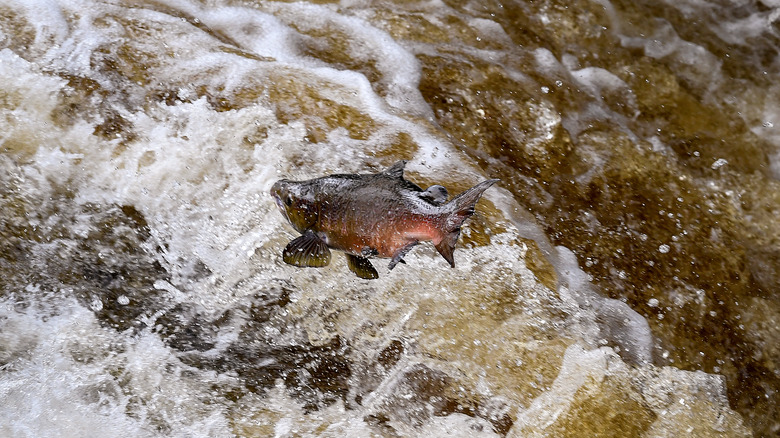The Real Difference Between Farmed Salmon And Wild Salmon
When you hop on the subway (late) and frantically tear off a mouthful of that paper-wrapped lox bagel, likely the last thing on your mind is where that salmon came from. But, give it a second thought.
U.S. consumers eat around 400,000 tons of salmon every year, according to Salmon Business. Zhang Yumei, a fisheries specialist at China's Academy of Agricultural Sciences, told Seafood Source that China consumes an estimated 16.5 million tons of salmon annually. People worldwide can't get enough of the stuff.
And for good reason: salmon is packed with health benefits, specifically omega-3s. The human body can self-generate most of the types of fats it needs to survive, according to Harvard, but that isn't the case for omega-3 fatty acids. They lower blood fat content, ease inflammation, and even speed up neurological development, among other things, via Web MD. These are essential fats and, since the body cannot manufacture them for itself, omega-3s must be obtained from food.
Not only are these fish heart-healthy giants — they're also delicious. There's nothing quite like biting into a perfectly cooked salmon fillet, or chowing down on some savory smoked salmon. But, there's a key distinction that separates farmed salmon from wild salmon — and it can make a bigger difference than you might think.
Farmed salmon
Half of all seafood consumed globally today is farmed, according to a peer-reviewed paper published in Environmental International (via Science Direct). In 2020, approximately 90.5 million metric tons of fish were captured from the wild, while 84.1 million metric tons were farmed, reports Statista. The Food and Agriculture Organization of the United Nations reported that by 2030 it's expected that two-thirds of the fish consumed around the world will be farmed. It looks like aquaculture is, for better or worse, here to stay.
Farmed salmon is typically Atlantic salmon, says Julia Zumpano, Rd, of the Cleveland Clinic, and it is the most-eaten fish in the United States. However, its consumer-favorite flavor might not be something to cheer about. Salmon's popularity has largely depleted the wild stock swimming in the ocean, Zumpano explains, which affects the balance of the ecosystem. Aquaculture has stepped in to meet consumer demands, which have recently been rising more quickly than nature can keep up with.
According to Wild for Salmon, farmed salmon are also given altered feed in their controlled environment. They live on a diet high in fat and protein, often synthetic, which makes them physically larger for commercial distribution. Unfortunately, this artificially manipulated diet could have a negative impact on human nutrition and environmental health.
Wild salmon
Salmon caught in the wild is usually one of five types of Pacific salmon: chinook (king), sockeye, coho (silver), pink, or chum, via the Alaska Department of Fish and Game. Wild salmon live on a diet of smaller organisms found in their natural environment, including insects, shrimp, crayfish, worms, and even herring, per A to Z animals.
In their natural habitat of open waters, the fish are free to swim great distances and tend to live an overall healthier life before being caught, says Wild for Salmon. It's worth noting that salmon naturally like to swim for long distances; they're a migratory species. The famous Salmon Run is the seasonal migration of salmon from freshwater toward the upper parts of the rivers, to spawn in the areas near the ocean. This migration is an upstream swim through the waters of Alaska and British Columbia, Canada, per World Atlas. These little fish are tough as nails.
Taste and nutritional value
The main differences between farmed and wild salmon are taste and nutritional value. According to Niceland Sea Food, farmed salmon tends to have a milder taste and a tender texture, making it a popular choice for most palettes. Aquaculture also raises salmon to have large, fleshy sections of intramuscular fat, which creates moist, flaky, sizeable fillets once cooked. By contrast, wild salmon has a much stronger fishy flavor and tougher meat says the Marithyme Seafood Company.
The health benefits of farmed-versus-wild salmon aren't such a clear difference. According to Healthline, both types of salmon have about the same sodium and protein content. However, for a 113-gram portion of salmon — farmed varieties had 15 grams of fat, while wild only had 5 grams. In the same serving, farmed salmon had 10 milligrams of calcium, and wild had 39 milligrams.
Wild salmon might have less fat and more calcium, but that doesn't mean it's definitively healthier. Environment plays a huge role in salmon's nutritional value.
The close proximity of overcrowded aquaculture operations makes salmon more susceptible to the transfer of disease and bacteria, reports the Washington State Department of Health. On the flip side, the wild isn't a totally safe bet, either. Trace amounts of mercury and other toxic pollutants have been found in wild salmon, per WebMD; wild salmon's organic diet also varies in different regions with different resources, meaning one fillet might contain more nutrients than another.



